El Gordo Dried
RSP 13122
Grower: Zamir Punja
General Information
- Sample Name
- El Gordo Dried-20240416
- Accession Date
- April 24, 2024
- Reported Plant Sex
- Female
- Report Type
- Whole-Genome Sequencing
- Microbiome
- Krona Plot
- Fungal Microbiome
- Krona Plot
- Bacterial Microbiome
- Krona Plot
- Viral Microbiome
- Krona Plot
The strain rarity visualization shows how distant the strain is from the other cultivars in the Kannapedia database. The y-axis represents genetic distance, getting farther as you go up. The width of the visualization at any position along the y-axis shows how many strains there are in the database at that genetic distance. So, a common strain will have a more bottom-heavy shape, while uncommon and rare cultivars will have a visualization that is generally shifted towards the top.
Chemical Information
Cannabinoid and terpenoid information provided by the grower.
Cannabinoids
No information provided.
Terpenoids
No information provided.
Genetic Information
- Plant Type
- Type I
File Downloads
The bell curve in the heterozygosity visualization shows the distribution of heterozygosity levels for cannabis cultivars in the Kannapedia database. The green line shows where this particular strain fits within the distribution. Heterozygosity is associated with heterosis (aka hybrid vigor) but also leads to the production of more variable offspring. When plants have two genetically different parents, heterozygosity levels will be higher than if it has been inbred or backcrossed repeatedly.
The ratio of reads mapped to Y-contigs to reads mapped to the whole Cannabis genome (Y-ratios) has been demonstrated to be strongly correlated with plant sex typing. This plot shows the distribution of Y-ratios for all samples in our database which were sequenced with the same method (panel or WGS) as this sample and where this sample falls in the distribution.
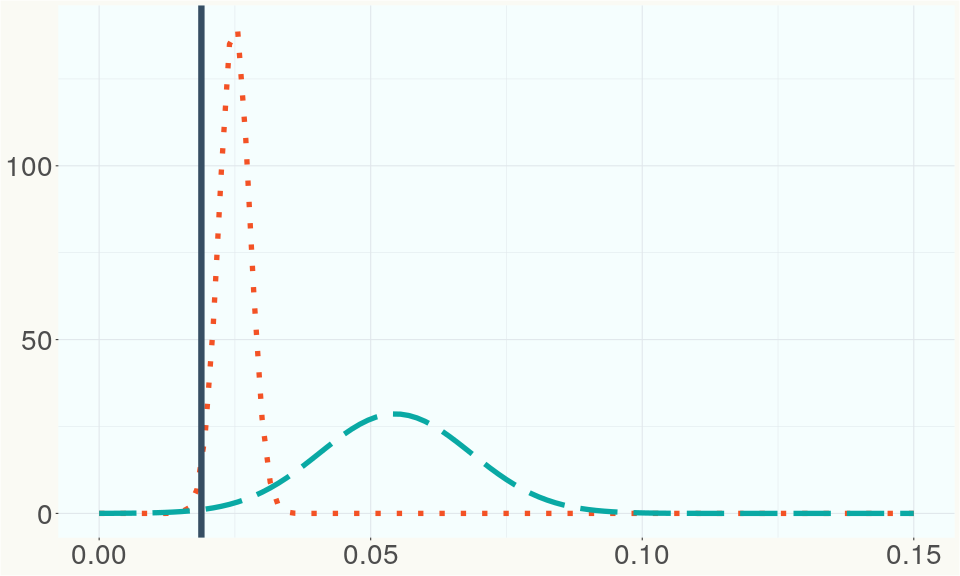
This chart represents the Illumina sequence coverage over the Bt/Bd allele. These are the three regions in the cannabis genome that impact THCA, CBDA, CBGA production. Coverage over the Active CBDAS gene is highly correlated with Type II and Type III plants as described by Etienne de Meijer. Coverage over the THCA gene is highly correlated with Type I and Type II plants but is anti-correlated with Type III plants. Type I plants require coverage over the inactive CBDA loci and no coverage over the Active CBDA gene. Lack of coverage over the Active CBDA and Active THCA allele are presumed to be Type IV plants (CBGA dominant). While deletions of entire THCAS and CBDAS genes are the most common Bt:Bd alleles observed, it is possible to have plants with these genes where functional expression of the enzyme is disrupted by deactivating point mutations (Kojoma et al. 2006).
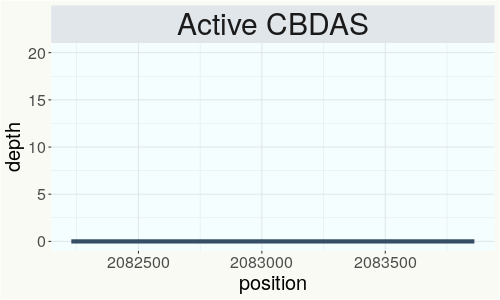
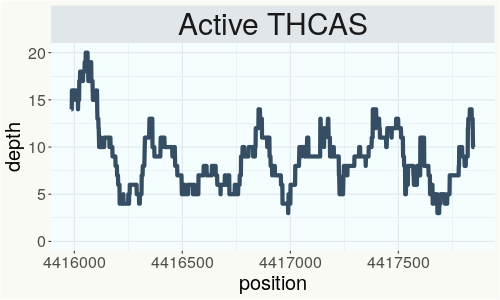
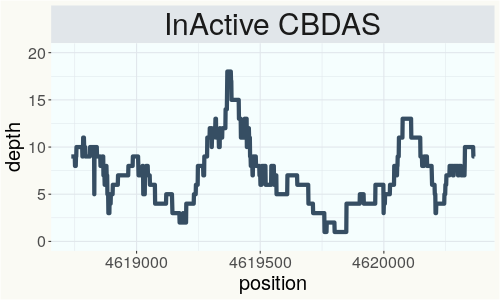
This chart represents the Illumina sequence coverage over the CBCA synthase gene.
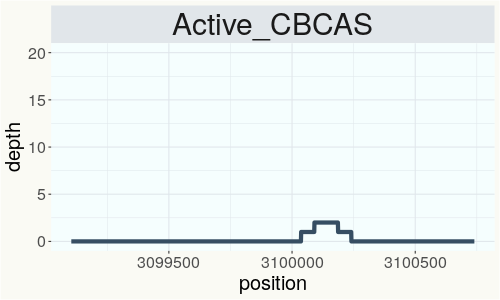
Variants (THCAS, CBDAS, and CBCAS)
No variants to report
Variants (Select Genes of Interest)
| PHL-2 | c.1057A>G | p.Arg353Gly | missense variant | moderate | contig2621 | 340335 | A/G | |
| FAD2-2 | c.196T>C | p.Phe66Leu | missense variant | moderate | contig83 | 1803173 | A/G |
|
| FAD2-2 | c.172G>T | p.Asp58Tyr | missense variant | moderate | contig83 | 1803197 | C/A |
|
| FAD2-2 | c.161T>A | p.Leu54His | missense variant | moderate | contig83 | 1803208 | A/T |
|
| ELF3 | c.1466G>A | p.Ser489Asn | missense variant | moderate | contig97 | 244297 | G/A |
|
| AAE1-3 | c.293A>G | p.Asp98Gly | missense variant | moderate | contig976 | 1083732 | T/C |
|
| AAE1-3 | c.214G>T | p.Glu72* | stop gained | high | contig976 | 1083861 | C/A |
|
Nearest genetic relatives (All Samples)
- 0.049 EG2 Stems (RSP13095)
- 0.049 EG2 Roots (RSP13096)
- 0.058 EG2 Leaves (RSP13094)
- 0.058 El Gordo (RSP12938)
- 0.188 Chem 91 (RSP11185)
- 0.205 Mother s Milk No 31 (RSP11623)
- 0.236 Styrofoam Cup x Pearadise 6 (RSP12986)
- 0.238 Motor Breath 15 (RSP12093)
- 0.239 Pearadise x Orange Juice 4 (RSP12975)
- 0.241 GG 4 (RSP11461)
- 0.242 Styrofoam Cup x Cuban Linx 1 (RSP12984)
- 0.243 East Coast Sour Diesel (RSP10243)
- 0.244 GMO (RSP12091)
- 0.246 GMO x Zkittlez 43 (RSP11976)
- 0.247 RKM-2018-009 (RSP11100)
- 0.248 RKM-2018-002 (RSP11093)
- 0.248 Styrofoam Cup x Cuban Linx 4 (RSP12970)
- 0.249 Sour D (RSP11343)
- 0.250 Star Dawg (RSP11352)
- 0.251 Mandarin Meatball 4 (RSP12869)
Most genetically distant strains (All Samples)
- 0.525 Cherry Blossom (RSP11311)
- 0.510 Northern Skunk (RSP11456)
- 0.503 Cherry Blossom (RSP11314)
- 0.500 Cherry Blossom (RSP11335)
- 0.495 Cherry Blossom (RSP11308)
- 0.491 Cherry Blossom (RSP11317)
- 0.489 Cherry Blossom (RSP11324)
- 0.484 Cherry Blossom (RSP11334)
- 0.480 Unknown- Cherry Wine - 004 (RSP11271)
- 0.479 Cherry Blossom (RSP11333)
- 0.476 Cbot-2019-005 (RSP11133)
- 0.473 Jamaican Lion (RSP12913)
- 0.472 Tiger Tail 30 (RSP11484)
- 0.469 Feral (RSP10891)
- 0.468 CS (RSP11208)
- 0.467 Ruderalis Indica (SRR14708267)
- 0.467 R1in136 (SRR14708227)
- 0.466 VIR 449 - Szegedi 9 (SRR14708213)
- 0.465 Beniko (SRR14708275)
- 0.464 Feral (RSP11206)
Nearest genetic relative in Phylos dataset
- Overlapping SNPs:
- 8
- Concordance:
- 6
Nearest genetic relative in Lynch dataset
- Overlapping SNPs:
- 3
- Concordance:
- 3
Blockchain Registration Information
- Transaction ID
-
ddc110e64bbab359
9b2e63b1065daf85 fea37a5b84367468 b66fdda4f95a0b2f - Stamping Certificate
- Download PDF (39.7 KB)
- SHASUM Hash
-
389091f67784a740f650da4e54c9fcf8 d9da6ac32434ef21 f284b3e977a22504